About
Relevant information about the referendum on electoral reform.

About The Referendum
This referendum is asking the citizens of BC to keep the old electoral system or to switch to a new one, proportional representation. The BC NDP made a commitment during the 2017 election to look into and actively campaign for electoral reform. That is the reason we are having a referendum now. There have been two past referendums on electoral reform: one in 2005 and one in 2009. The first referendum concerned a system called BC STV and resulted in a close vote with 57.7% of the popular vote in favor of the change. A majority of voters in 77 out of 79 districts voted yes, however that referendum failed as it did not reach its 60% requirement and BC STV was not adopted. In 2009, BC citizens voted again on BC STV. The results for that referendum were vastly different from 2005 with just 39.1% of the people voting in favor and 60.9% voting against.
After The Referendum
If proportional representation wins a 50% majority, district
boundaries will need to be redrawn. Since most of the districts will
grow as much as seven-fold in size, how districts and regions will
merge and be created is yet to be decided. For one of the systems, we
need to figure out whether or not the ballot should be split and which
type of party list should be used. As the system will elect between 87
and 95 MLAs, the exact number would need to be established beforehand.
If electoral change is supported by a majority of voters, it will be
implemented in time for any election called after July 1, 2021. A
second referendum will be held after two elections under the new
proportional representation system asking if we should keep it.
How Proportional Representation Would Have Changed Past Elections
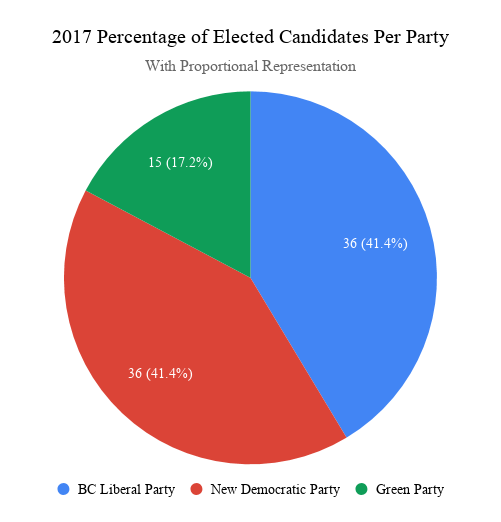
.png?1542946683838)
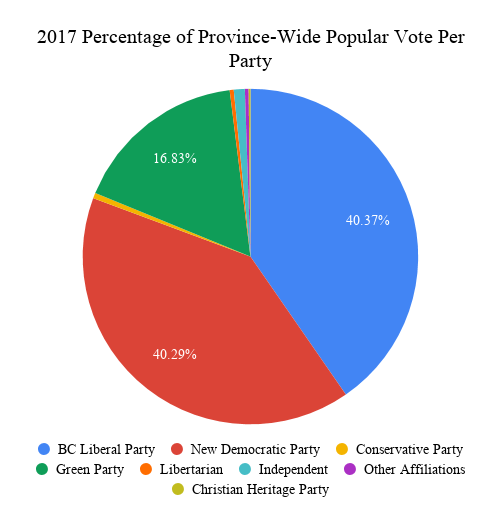
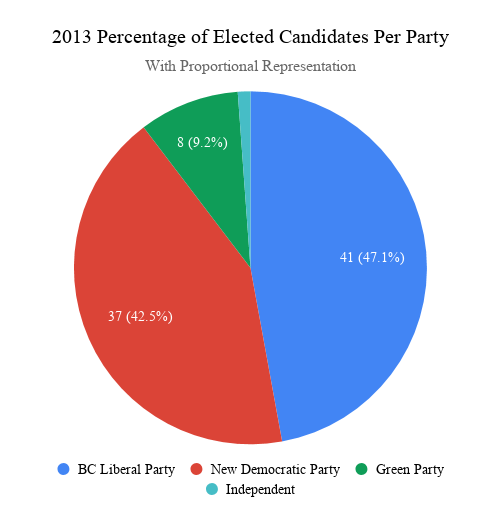
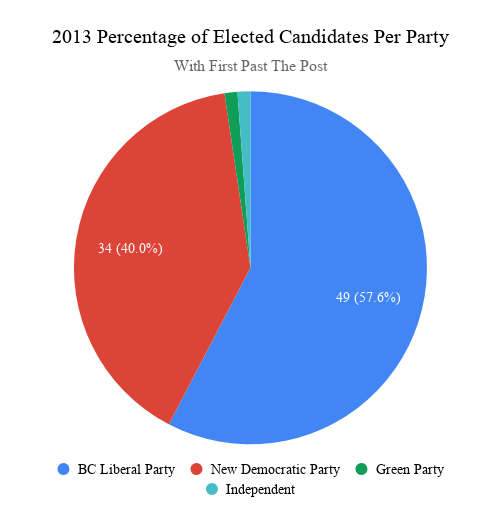
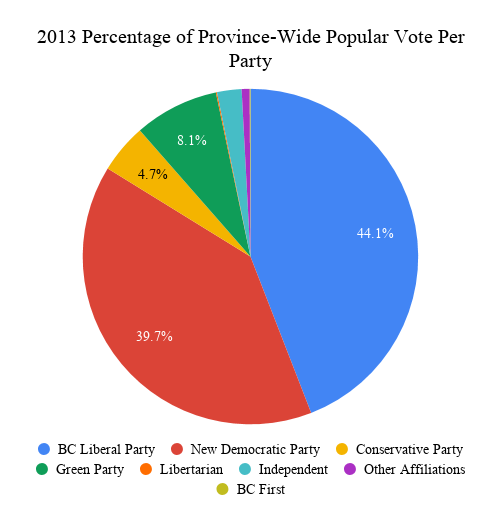
%20copy.png?1542946675718)
.png?1542946675736)

The Systems
The referendum asks voters two questions. The first: Whether we should keep our First Past The Post electoral system or change to a proportional representation system. The second: Which proportional representation should be used if we change to proportional representation.
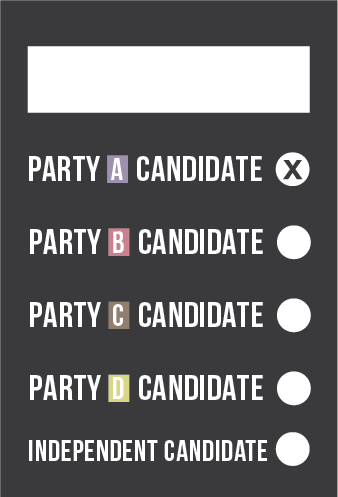
|
What Is First Past The Post?
Our current electoral system, First Past The Post, is based on simple majorities. This means that the candidate that wins the most votes, not necessarily the majority, is elected. Districts are represented by just one MLA. The number of seats each party holds in the legislature mirrors the number of districts that party won. As a result, many voters lack representation. In its favor, First Past The Post usually creates majority governments and is simple to use and understand. All of Canada uses First Past The Post as well as the U.K., the United States, and India.
What Is Proportional Representation?
Proportional Representation is an electoral system in which the percentage of votes parties receive are reflected proportionally in the government. If a party wins 40% of the vote, they win 40% of the seats. It is a fair system where every vote counts. This system normally results in minority governments where coalitions are necessary to form a government. Many countries currently use proportional representation to elect their government including Belgium, Finland, Australia, and Switzerland. There are many different ways to achieve a proportional government. In this referendum, three have been proposed. Each will have larger districts, 87 to 95 MLAs, and the percentage of votes will roughly equal the percentage of seats held. With proportional representation, voters are represented by more than one MLA and candidates from both small and large parties have a fair chance of getting elected.
How It Will Affect Richmond
Right now, Richmond has four districts and all of them are represented by Liberal MLAs. However, 52% of voters did not vote for Liberals. If the 2017 election used proportional representation, just two Liberal MLAs would have been elected. The other two seats would have been filled by the NDP and the Green Party. The district boundaries will also change but that is dependent on the system chosen whether DMP, MMP, or RUP.
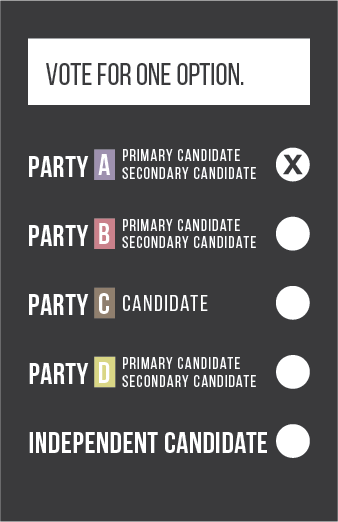
|
Dual Member Proportional (DMP)
In Dual Member Proportional, voters directly pick their MLA while the
percentages of votes and MLAs are proportional. Districts will be
grouped together so each electoral district has two MLAs, though
larger rural districts will stay the same with one MLA elected in the
same fashion as First Past The Post where whoever gets the most votes
is elected. In combined districts, voters are voting more for the
party rather than an individual candidate. Parties are allowed to have
up to two candidates on the ballot and decide who is listed first and
second in their party section. The voting process stays relatively the
same; each voter marks the ballot once beside the party they prefer.
A main component of Dual Member Proportional is that there
are first seats and second seats. Both get filled in a different way.
The first seats are filled in districts by the candidate listed first
on the ballot for the party that got the most votes. Second seats,
however, are given out to candidates to make sure the province-wide
popular vote matches the number of candidates elected from each party.
A district's second seat can be filled by a candidate whose party has
done well both provincially and in the district. This is how the
results become proportional and match up very well. To win a second
seat, parties must have at least 5% of the votes province-wide. The
only exception to this rule is for independents; they win a seat if
they have the most or the second-most votes in the district.
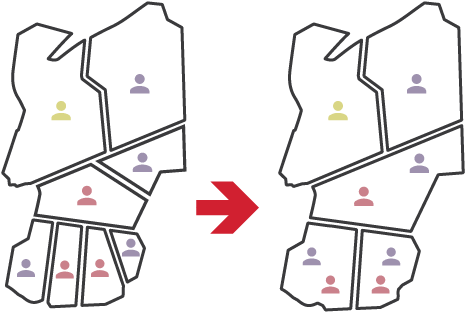
|
- Two MLAs per district (excluding already large rural districts)
- Ballot has up to two candidates per party
- Familiar (still uses FPTPS in some parts of the process)
- Direct relationship between number of votes and number of MLAs
- All local MLAs
- Should improve chances for independents to be elected
- Invented in Canada (never been used anywhere before)
Key Points of DMP
How DMP Will Affect Richmond
Dual Member Proportional will change our four districts into two. Each will have two MLAs representing them.
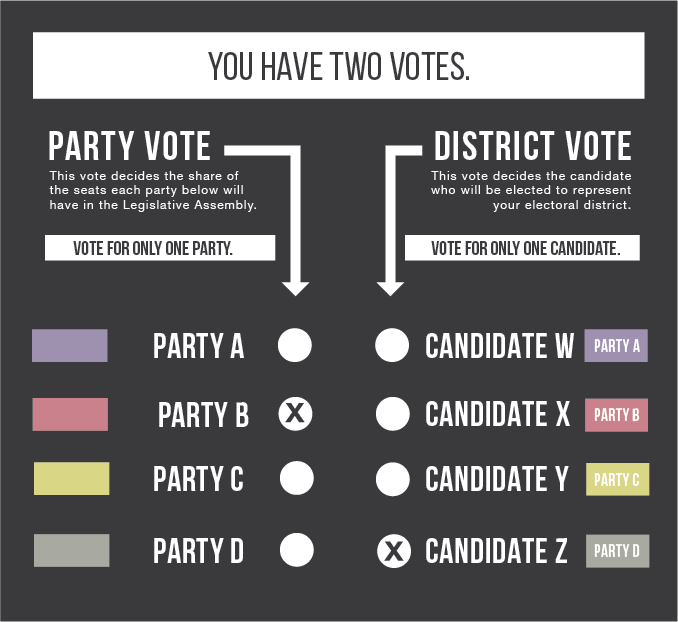
|
Mixed Member Proportional (MMP)
Mixed Member Proportional, the second electoral system, is used in
Germany, Bolivia, New Zealand, and Scotland among others. It is
characterized by two different types of MLAs. One represents the
district and uses simple majorities, like First Past The Post. These
are district MLAs. Regions are created from groups of districts and
have regional MLA’s to represent them. They are elected from a party
list of candidates that has been put forward by each party. As with
Dual Member Proportional, a party needs at least 5% of the province’s
vote to gain a regional seat. Regional seats are used to make sure
parties' regional votes and seats ratios match up and the results are
as proportional as possible. They are given out based on regional
percentages, not provincial ones. Although if the percentage of seats
corresponds with each region’s percentages of votes, it will roughly
match the provincial shares automatically. At least 60% of MLAs will
be elected as district MLAs. The rest will be regional MLAs.
The ballot style needs to be decided if this system is chosen. Voters
can either have one vote which counts for a district candidate and
their party or they can have two votes, one for a district candidate
and another for a party list. The party list can be closed, open, or
open with a party option. With a closed party list, voters don’t see
the list on the ballot and vote for an entire party. On an open list,
the list appears on the ballot and voters vote for one candidate from
the list. An open list with a party option gives voters the option to
either vote for one candidate on the list or for the entire party. The
party list is used solely for selecting regional MLAs and will be
presented separately alongside district MLA candidates on the ballot.
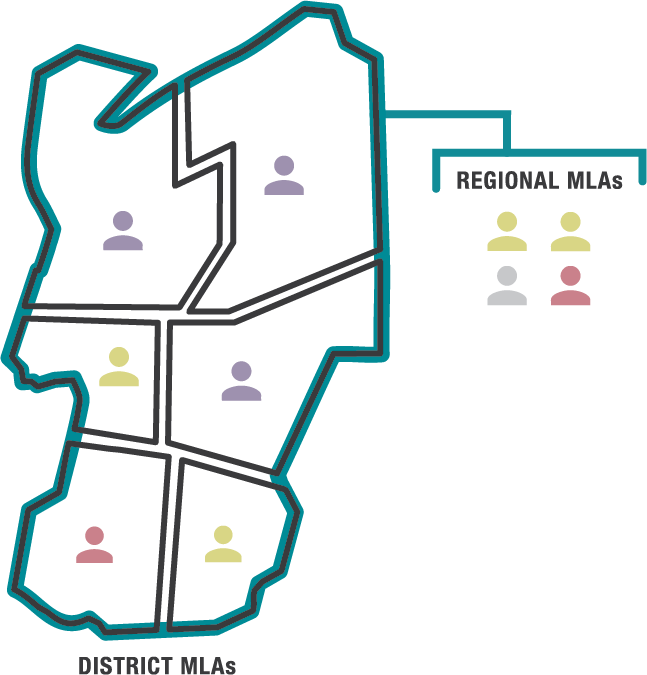
|
District seats + Regional seats = parties share of province-wide vote percentages
- Single member districts with Regional MLAs
- Familiar (still uses FPTPS in some parts of the process)
- Been tried and tested in different governments world-wide
- Ballot style still needs to be decided
- Regional MLAs are not always directly elected by voters
Key Points of MMP
How MMP Will Affect Richmond
Mixed Member Proportional will most likely, as with Dual Member Proportional, have two districts instead of four. These two districts will have one MLA from each in the legislature. Our two districts will be a part of a larger region with regional MLAs.
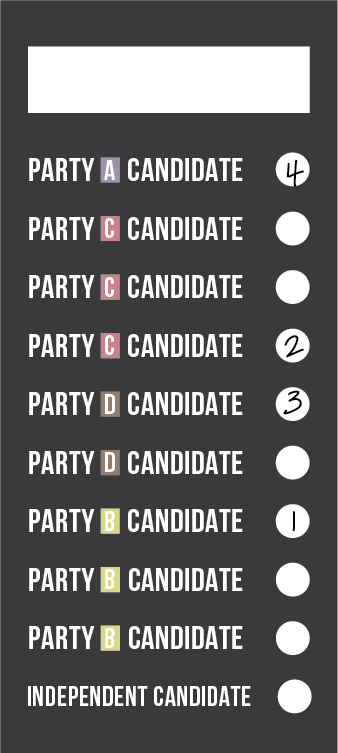
|
Rural-Urban Proportional (RUP)
This system uses the Single Transferable Vote for urban and semi-urban districts, while rural districts use Mixed Member Proportional. Each district will have multiple MLAs representing them since districts will be significantly larger than under the current FPTP system. Single Transferable Vote (STV) is a preferential ballot system where voters rank as many candidates as they wish in order of preference. Candidates elected by this system must reach a predetermined quota of votes. If this quota is not reached, multiple rounds of counting are required where surplus votes are transferred to other candidates and candidates with the lowest number of votes are dropped until enough candidates reach the quota. The surplus votes and votes of dropped candidates are transferred based on voters' next choices on the ballot. Parties can run as many candidates as there are seats in the district. There will be 2 to 7 MLAs in urban districts. Rural districts will have district and regional MLAs and use exactly the same system as Mixed Member Proportional.
- Uses a ranked ballot
- Uses two different systems for rural districts and urban ones
- Improves chances for independents to be elected
- Voters have a lot more choice on the ballots
- STV is not directly proportional
- STV and MMP are used in other countries, but not together
Key Points of RUP

|
How RUP Will Affect Richmond
With STV, our four districts may be combined into one district with four MLAs. Every voter in Richmond will get a say in which four MLAs will be elected to represent our district.
My Opinion
What I think about Proporitonal Representation and its systems.
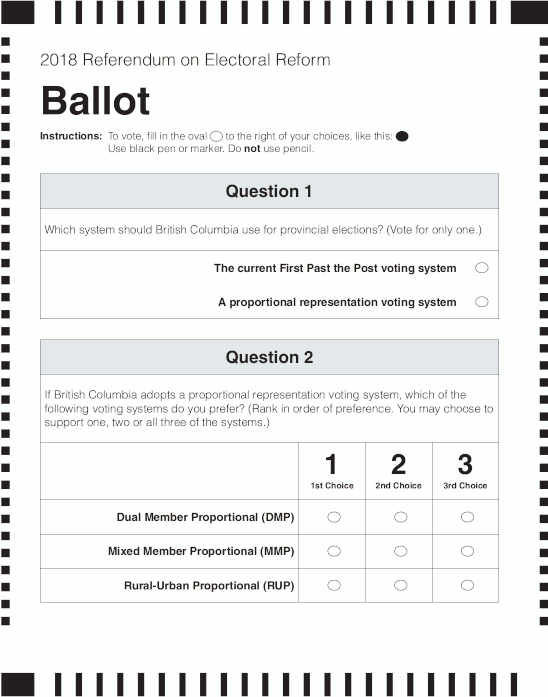
|
How I Would Vote
I definitely would vote for a proportional representation system over
our First Past The Post system. I think that reforming our electoral
system is a very good thing, and if we don’t like it, we can change it
back after two elections.
While it was very difficult to
choose between Dual Member Proportional, Mixed Member Proportional,
and Rural-Urban Proportional, I prefer the Mixed Member Proportional
system. The reasons behind my decision include that I like the idea of
district and regional MLAs. It still has the same feel of our current
system, but the results are a lot more proportional and fair. I think
the government should have decided on the ballot style before they
sent out the referendum. Nevertheless, since the other countries that
use MMP have a split ballot, I think split ballot with closed party
list is the best option and will probably be selected. The idea of
having two votes on the ballot will give me more choice when I am old
enough to vote. One part of MMP I feel is a large disadvantage is that
the odds for Independent candidates to win a seat stay the same, very
low.
My second choice of PR systems is Rural-Urban
Proportional. I really like the ranked ballot, however, I don’t like
how there are two different systems for urban districts and rural
districts. Also, RUP isn’t directly proportional and the process of
counting votes is complicated.
I don’t like the Dual
Member Proportional system because it has never been used before and
there is no separation between voting for a candidate and voting for a
party. How second seats are awarded, while I understand it, is
complex. Even though the referendum guide says different, I feel as if
some districts may get candidates that almost no one in that district
voted for just because the party needed a seat to match shares of
provincial votes.
If I could vote, I would vote in favor
of Proportional Representation. My first choice would be Mixed Member
Proportional, my second choice would be Rural-Urban Proportional, and
my last choice would be Dual Member Proportional.
Additional Resources
For a helpful quiz go to referendumguide.ca.
Go straight to the source at elections.bc.ca/referendum.
A quick video on the different systems can be found at thetyee.ca/PR-Explained-Video.
For another summary of the referendum, visit dailyhive.com.
More information that is easy to understand on Dual Member Proportional, Mixed Member Proportional, and Rural Urban Proportional.